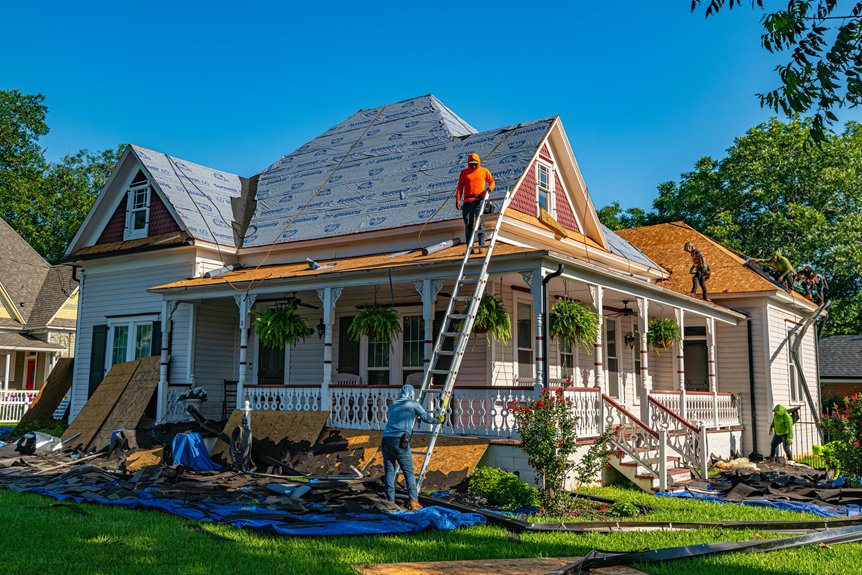After replacing your roof in Midwest City, ongoing maintenance is key to protecting your investment and ensuring it lasts. Regular inspections and small repairs can prevent costly damage down the line. But where should you start, and what steps are most effective? Keeping an eye on your roof’s condition and addressing issues early can make all the difference—yet many homeowners overlook these simple, vital tasks. Here’s what you need to know to keep your roof in top shape.
Regular Inspections and Visual Checks
Regular inspections and visual checks are essential to maintaining your roof’s integrity after a replacement. You should regularly examine your roof for signs of damage or wear, especially after storms or severe weather.
Pay close attention to roof ventilation — ensuring vents are clear and functioning properly helps prevent moisture buildup. Proper attic insulation also plays a key role; check that insulation remains evenly distributed and isn’t compressed or damaged, as poor insulation can lead to heat loss or ice dams.
Look for any sagging, missing shingles, or debris that could trap moisture. Regularly inspecting these components helps you catch issues early, preventing costly repairs down the line. Additionally, scheduling professional roof inspections can provide a comprehensive assessment and help identify hidden problems before they escalate.
Staying proactive guarantees your roof stays durable, efficient, and protected year-round.
Keep Gutters and Downspouts Clear
Keeping your gutters and downspouts clear is essential to preventing water damage after roof replacement. Leaf buildup can quickly clog your gutters, leading to overflowing and potential damage to your roof and foundation.
Regularly removing debris ensures water flows freely, reducing the risk of leaks and gutter repairs down the line. Check for signs of blockages after storms or heavy winds, and clear out any leaves, twigs, or dirt.
If you notice sagging or leaks, address gutter repairs promptly to maintain proper drainage. Maintaining clean gutters also helps prevent ice dams in colder months.
Scheduling routine cleanings and inspections keeps your system functioning effectively, protecting your investment and avoiding costly repairs caused by water intrusion. Stay vigilant to keep your roof and home safe.
Trim Overhanging Branches and Vegetation
Overhanging branches and nearby vegetation can pose serious risks to your roof if left unchecked. Overgrown limbs can scrape and damage shingles, especially during wind storms, and falling branches can cause costly repairs. To prevent this, perform regular tree trimming to keep branches away from your roof and reduce the risk of damage.
Vegetation control is also essential; removing vines and other plants that cling to your roof or gutters minimizes moisture buildup and mold growth. Use proper tools and techniques to safely trim trees and bushes near your home.
Keeping vegetation well-maintained not only protects your roof but also extends its lifespan. Regularly inspecting your trees and plants ensures they stay a safe distance away from your roof, preventing potential hazards before they occur.
Address Any Minor Damage Promptly
Even minor damage to your roof can quickly escalate into more serious issues if not addressed promptly. Small cracks or loose shingles from storm damage can allow water to seep in, leading to leaks and structural problems.
Ignoring minor issues also increases the risk of pest infestation, as pests can enter through tiny gaps or holes. By inspecting your roof regularly and fixing small damages right away, you prevent further deterioration and costly repairs.
Promptly repairing storm damage minimizes the chance of water intrusion and mold growth. Additionally, sealing small gaps helps keep pests out, protecting your home’s interior.
Taking quick action on minor damage preserves your roof’s integrity and extends its lifespan, ensuring your home remains safe and secure after your roof replacement.
Schedule Professional Roof Assessments
After addressing minor damages promptly, it’s a good idea to bring in a professional for a thorough roof assessment. Regular inspections help identify issues with roof ventilation that could cause excess moisture buildup or heat retention, which can damage your roof over time.
During the assessment, a professional will also check your attic insulation, ensuring it’s adequate and properly installed. Proper attic insulation works hand-in-hand with ventilation to prevent ice dams, reduce cooling costs, and prolong your roof’s lifespan.
Scheduling these assessments annually or after severe weather ensures you catch potential problems early. A professional evaluation helps you maintain your roof’s integrity, optimize energy efficiency, and avoid costly repairs down the line.
Don’t wait—regular assessments are key to long-lasting roof health.
Conclusion
By staying on top of these maintenance tips, you’ll keep your Midwest City roof in great shape for years to come. Regular inspections, gutter cleaning, trimming branches, and prompt repairs help prevent costly damage. Don’t forget to schedule professional assessments annually or after storms. For more information on how to schedule your free roof inspection, call us at (405) 543-2920 or visit us online at Top View Roofing. Taking these simple steps guarantees your roof remains durable, protecting your home and loved ones. Stay proactive, and your roof will serve you well longer.











